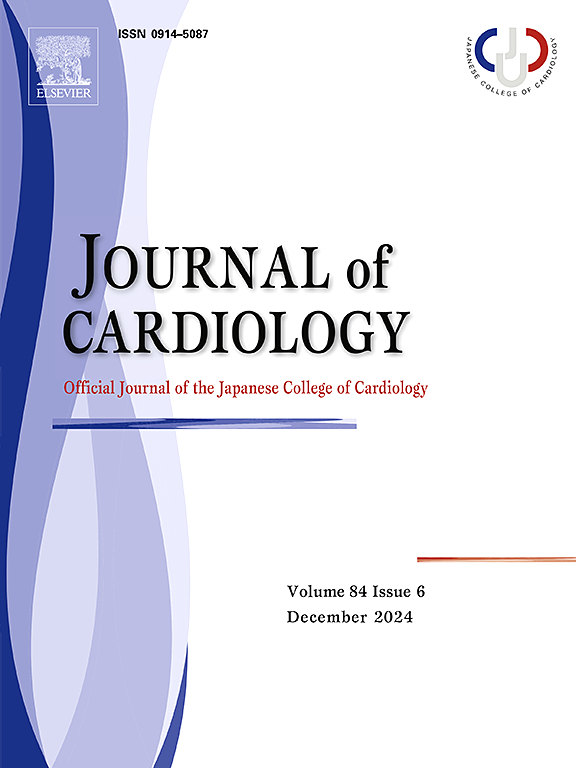卷积神经网络增强心电图在检测急性冠状动脉综合征中的表现:关注亚型和减少导联。
IF 2.6
3区 医学
Q2 CARDIAC & CARDIOVASCULAR SYSTEMS
引用次数: 0
摘要
背景:急性冠脉综合征(ACS)的早期和准确诊断,特别是非st段抬高ACS (NSTE-ACS),仍然是急诊环境中的一个关键挑战。尽管诊断方式取得了进步,但传统的心电图(ECG)解释往往无法检测到细微的缺血性变化,特别是在NSTE-ACS中,这突出了对人工智能(AI)驱动方法的需求。方法:本研究回顾性分析单中心队列(Shinken数据库2010-2022,n = 32167)的数据,开发用于ACS检测的ai驱动ECG模型。采用卷积神经网络(CNN)模型和集成神经网络(INN)模型,结合ACS亚型和靶血管的诊断概率,对全导联心电图和减少导联心电图模型的受者工作特征曲线下面积(AUROC)、精确召回率曲线下面积(AUPRC)、灵敏度和F1评分进行评估。结果:采用全导联心电图的CNN模型AUROC为0.877,AUPRC为0.391,F1评分为0.184,INN模型结果相似(AUROC为0.889,AUPRC为0.356,F1评分为0.188)。对于与NSTE-ACS相关的亚型,采用全导联心电图的CNN模型(采用双导联心电图的CNN模型)对于不稳定型心绞痛的AUROC为0.785(0.783),敏感性为0.723(0.672),特异性为0.699(0.768);对于nste -心肌梗死的AUROC为0.795(0.786),敏感性为0.527(0.567),特异性为0.878(0.849)。在肌钙蛋白检测患者(n = 4169)中,CNN模型的敏感性为76 %,阳性预测率(PPR)为32 %,F1评分为0.452,INN模型分别为78 %、35 %和0.483。在降铅模型中,导联I和II模型AUROC最高(0.866),CNN和INN模型肌钙蛋白检测患者F1评分分别为0.395和0.390。结论:CNN增强和inn增强对包括NSTE-ACS在内的伴有轻微缺血性心电图改变的ACS均有较好的检测效果。然而,低PPR限制了这些模型的独立诊断效用。相反,它们有望成为辅助工具,特别是在资源有限的环境中,减少导联心电图可能是有益的。本文章由计算机程序翻译,如有差异,请以英文原文为准。

Performance of convolutional neural network-enhanced electrocardiography in detecting acute coronary syndrome: focusing on subtypes and reduced leads
Background
Early and accurate diagnosis of acute coronary syndrome (ACS), particularly non-ST-elevation ACS (NSTE-ACS), remains a critical challenge in emergency settings. Despite advancements in diagnostic modalities, conventional electrographic (ECG) interpretation often fails to detect subtle ischemic changes, particularly in NSTE-ACS, highlighting the need for artificial intelligence (AI)-driven approaches.
Methods
This study retrospectively analyzed data from a single-center cohort (Shinken Database 2010–2022, n = 32,167) to develop AI-driven ECG models for ACS detection. A convolutional neural network (CNN) model and an integrated neural network (INN) model, which incorporated diagnostic probabilities for ACS subtypes and target vessels, were evaluated using area under the receiver operating characteristics curve (AUROC), area under the precision-recall curve (AUPRC), sensitivity, and F1 scores for all‑lead ECG and reduced‑lead ECG models.
Results
The CNN model using all‑lead ECG achieved an AUROC of 0.877, an AUPRC of 0.391, and an F1 score of 0.184, while the INN model showed similar results (AUROC 0.889, AUPRC 0.356, and F1 score 0.188). For subtypes related to NSTE-ACS, the CNN model using all‑lead ECG (CNN model using double‑lead ECG) model achieved an AUROC of 0.785 (0.783), sensitivity of 0.723 (0.672), and specificity of 0.699 (0.768) for unstable angina, and an AUROC of 0.795 (0.786), sensitivity of 0.527 (0.567), and specificity of 0.878 (0.849) for NSTE-myocardial infarction. Among patients with troponin testing (n = 4169), the CNN model achieved a sensitivity of 76 %, a positive predictive rate (PPR) of 32 %, and an F1 score of 0.452, while the INN model achieved 78 %, 35 %, and 0.483, respectively. The leads I and II model demonstrated the highest AUROC among reduced‑lead models (0.866), with F1 scores in patients with troponin testing of 0.395 and 0.390 for the CNN and INN models, respectively.
Conclusion
Both CNN and INN-enhanced ECGs demonstrated good performance in detecting ACS including NSTE-ACS with subtle ischemic ECG changes. However, low PPR limit these models' standalone diagnostic utility. Instead, they hold promise as supportive tools, especially in resource-limited settings where reduced‑lead ECGs may be beneficial.
求助全文
通过发布文献求助,成功后即可免费获取论文全文。
去求助
来源期刊

Journal of cardiology
CARDIAC & CARDIOVASCULAR SYSTEMS-
CiteScore
4.90
自引率
8.00%
发文量
202
审稿时长
29 days
期刊介绍:
The official journal of the Japanese College of Cardiology is an international, English language, peer-reviewed journal publishing the latest findings in cardiovascular medicine. Journal of Cardiology (JC) aims to publish the highest-quality material covering original basic and clinical research on all aspects of cardiovascular disease. Topics covered include ischemic heart disease, cardiomyopathy, valvular heart disease, vascular disease, hypertension, arrhythmia, congenital heart disease, pharmacological and non-pharmacological treatment, new diagnostic techniques, and cardiovascular imaging. JC also publishes a selection of review articles, clinical trials, short communications, and important messages and letters to the editor.
 求助内容:
求助内容: 应助结果提醒方式:
应助结果提醒方式:


